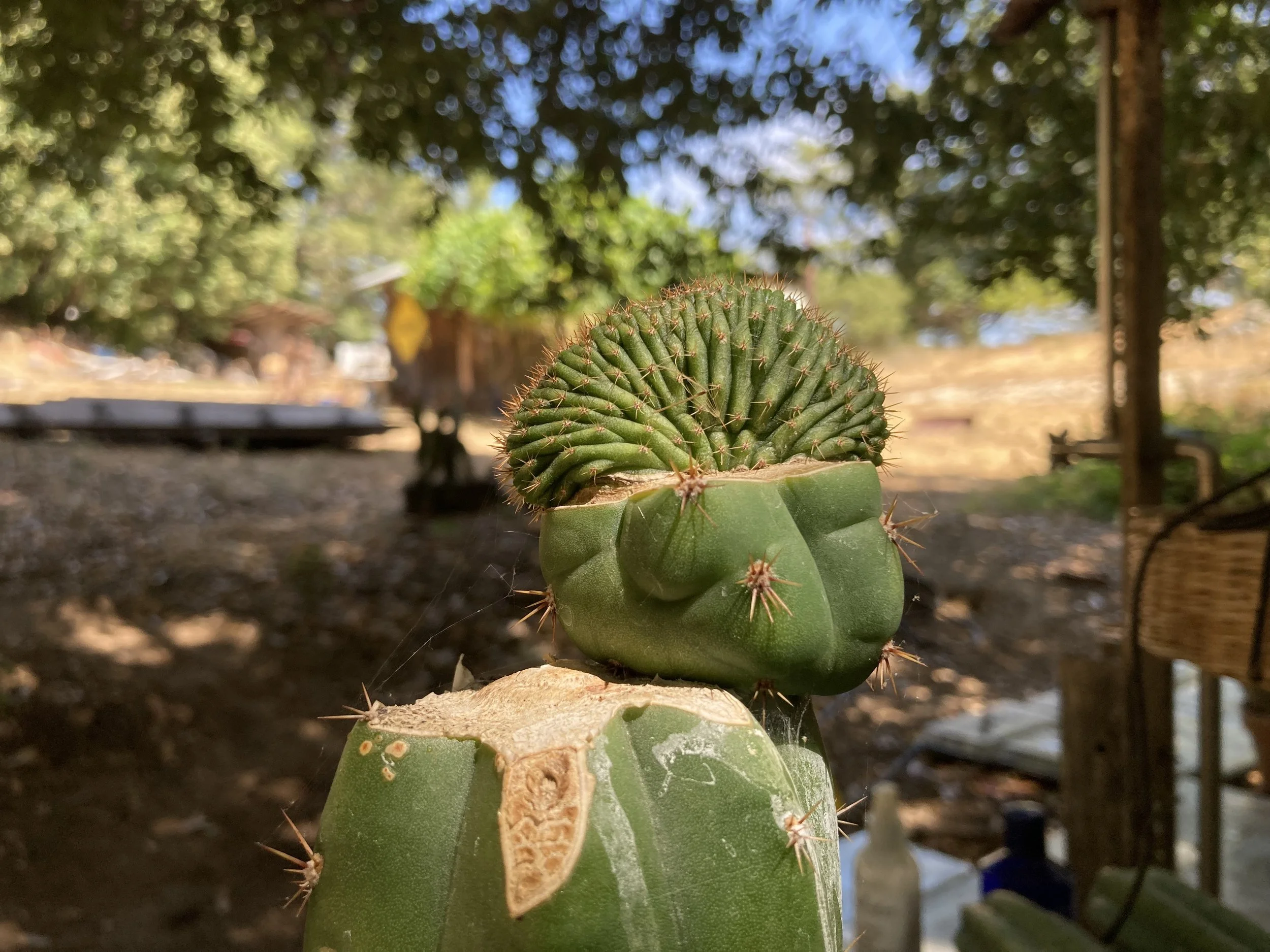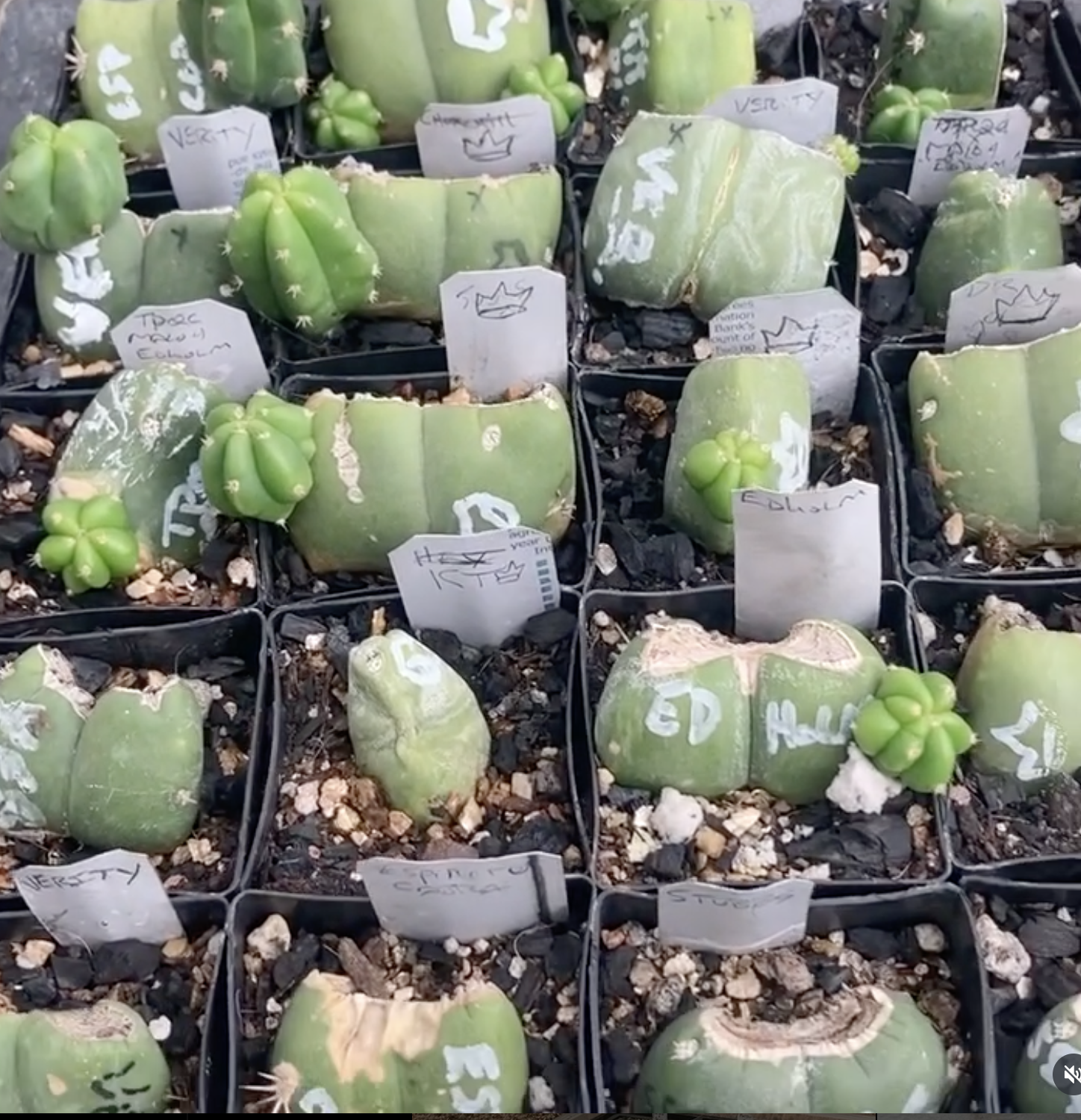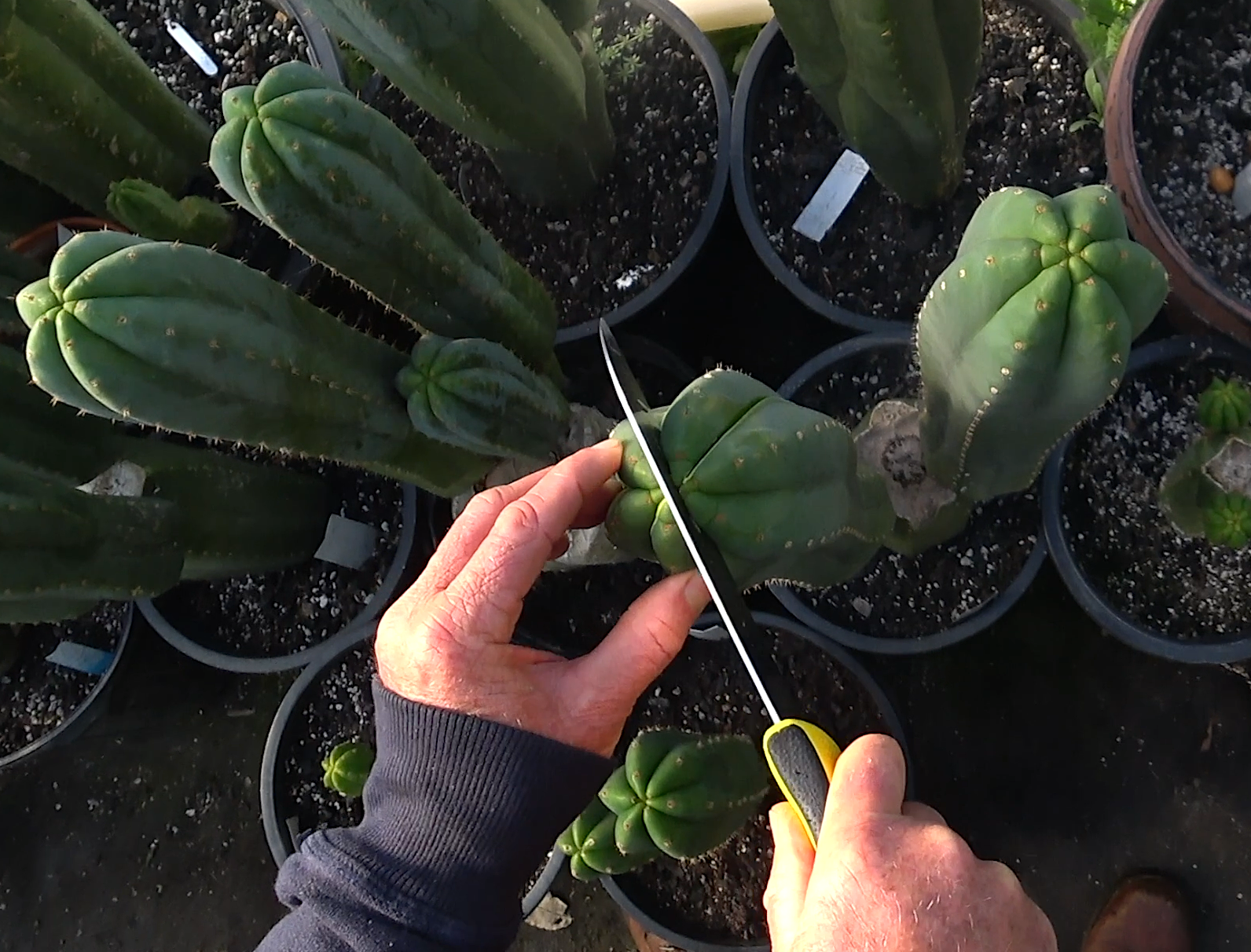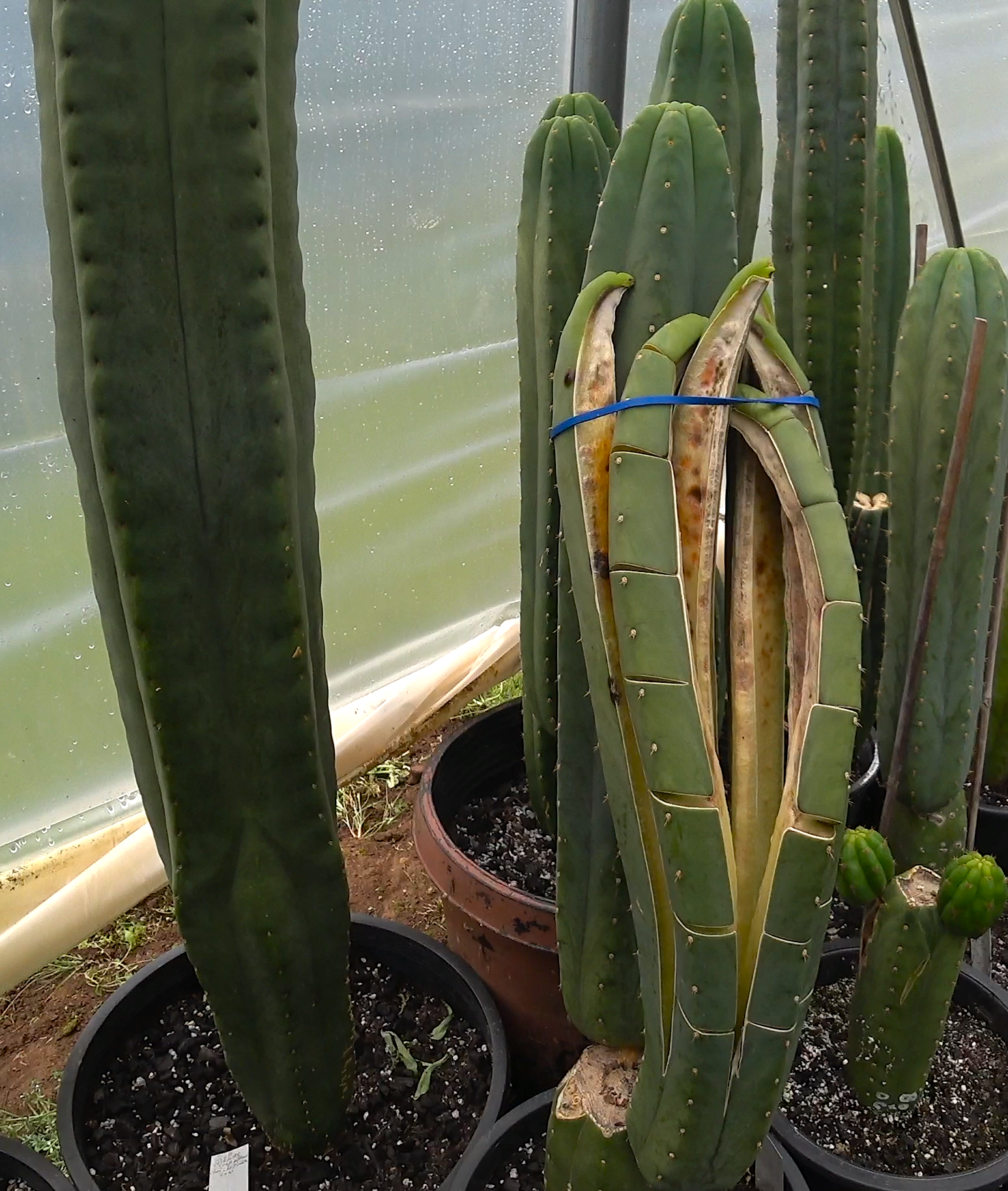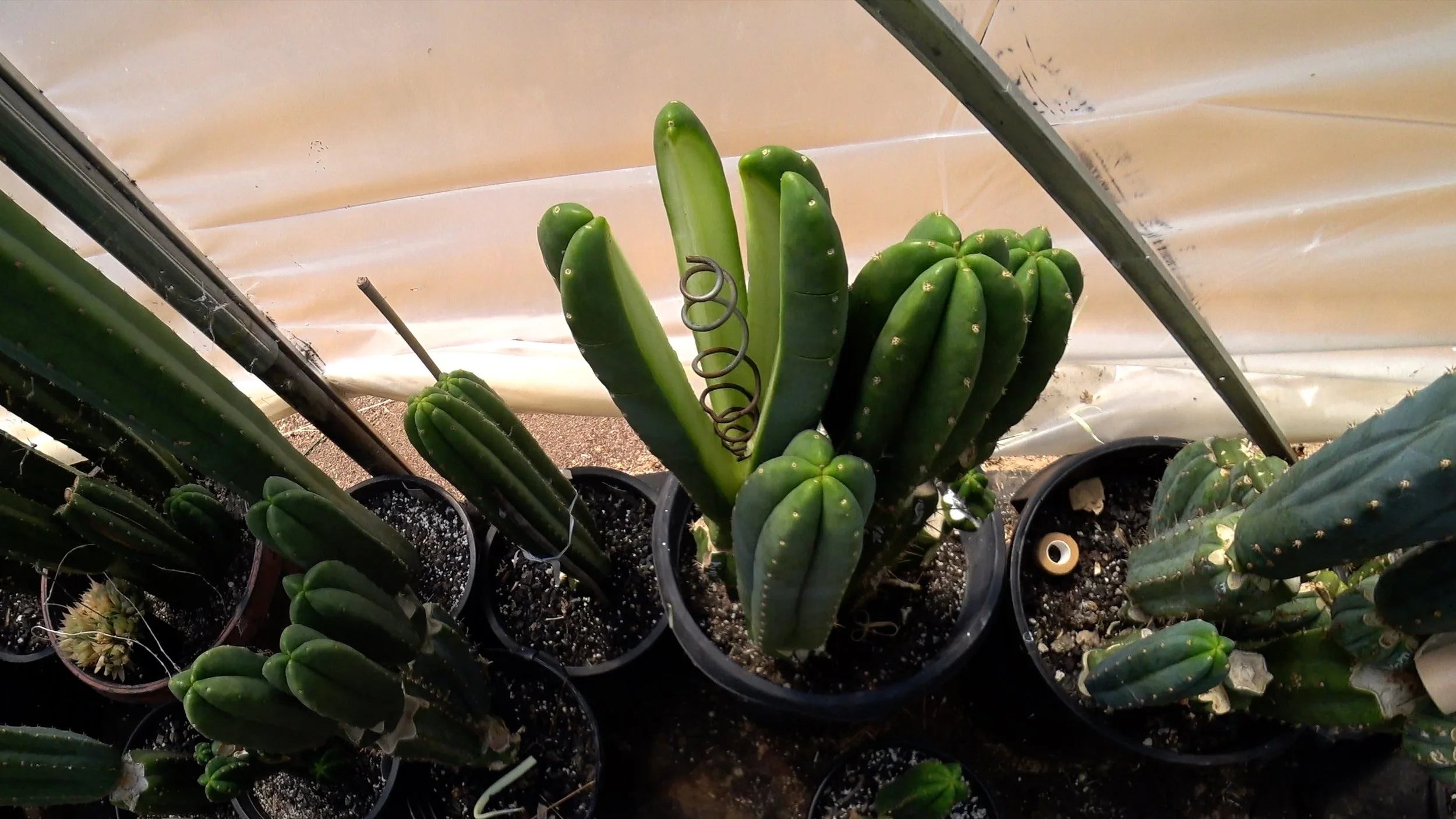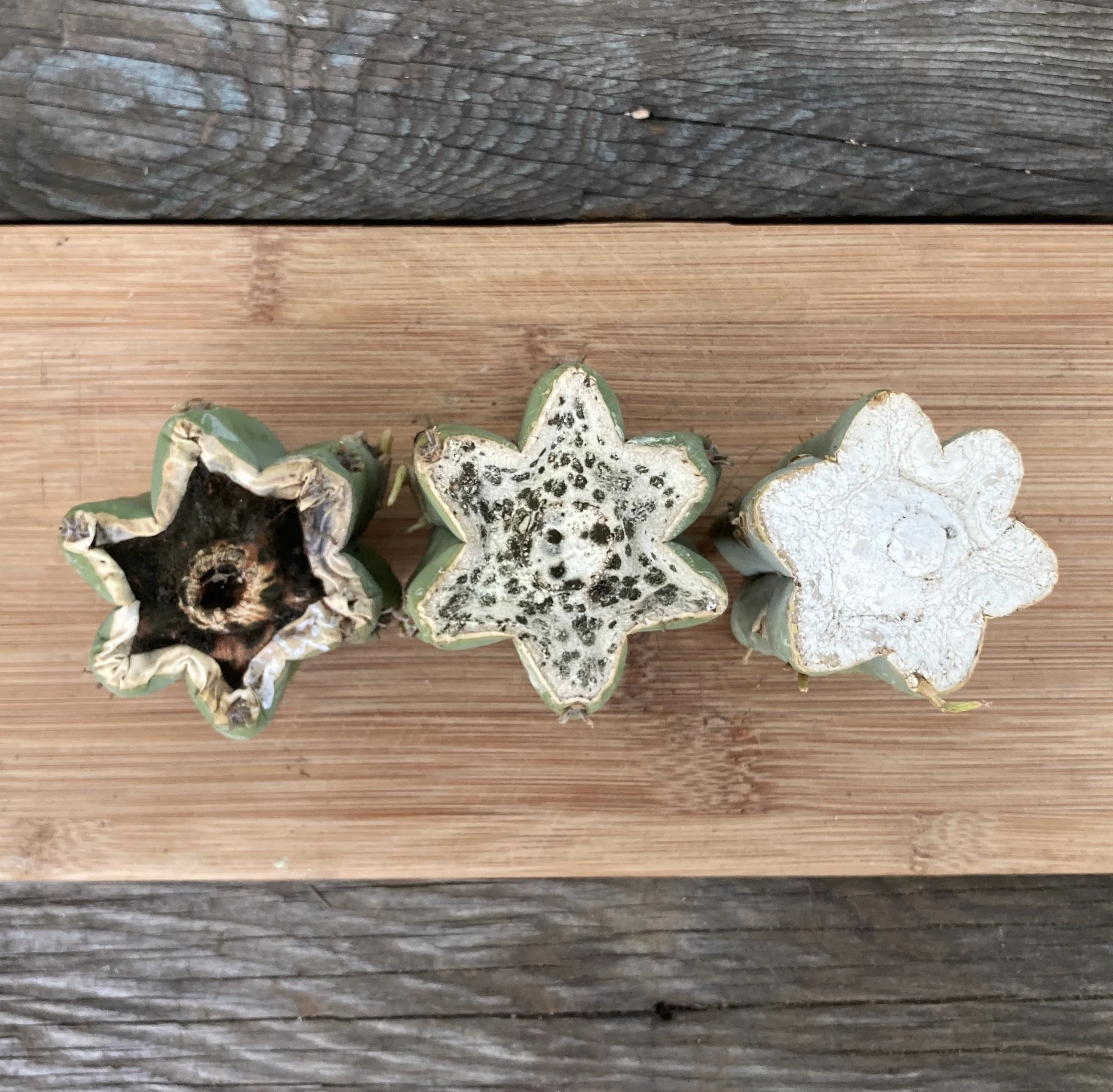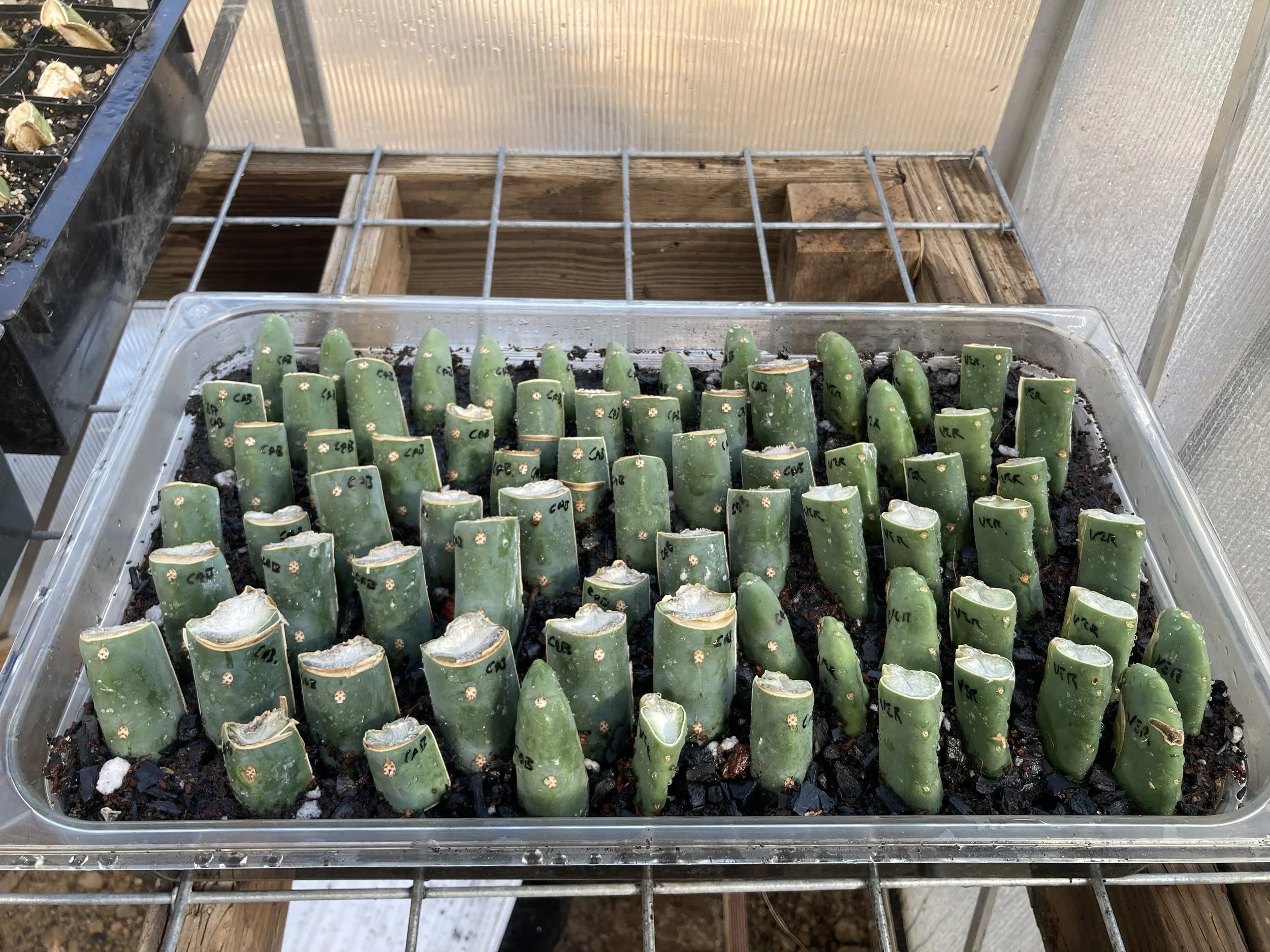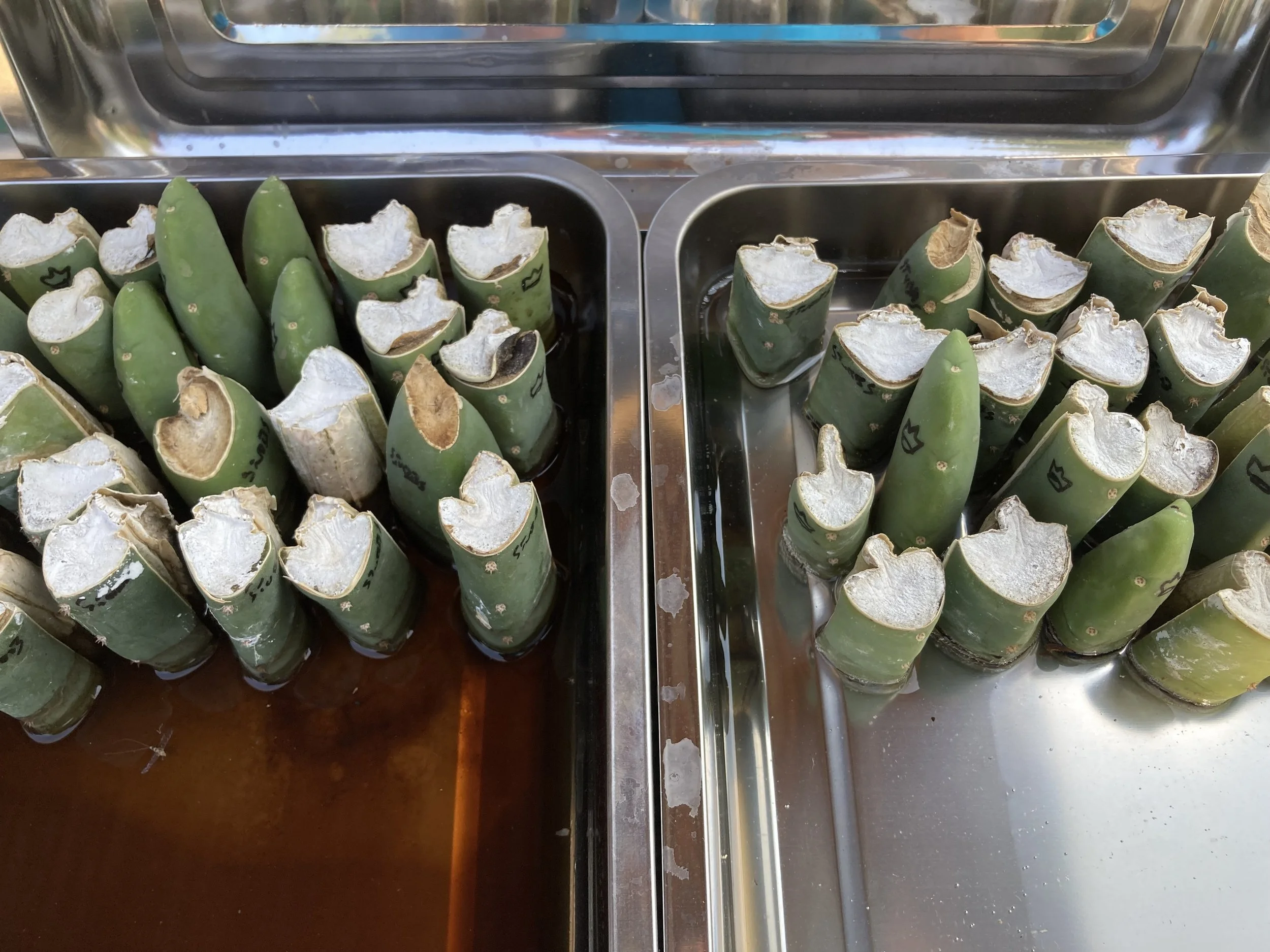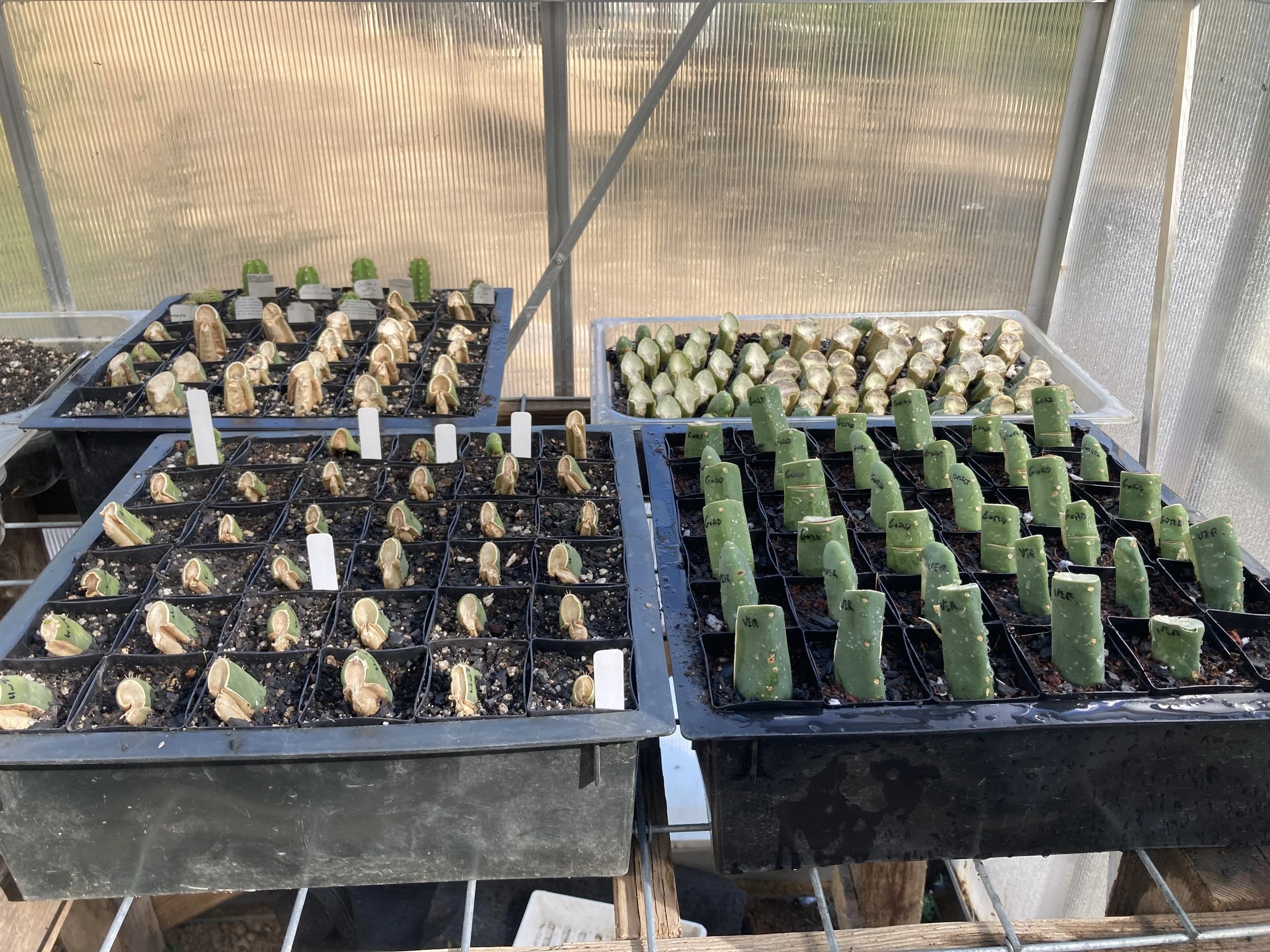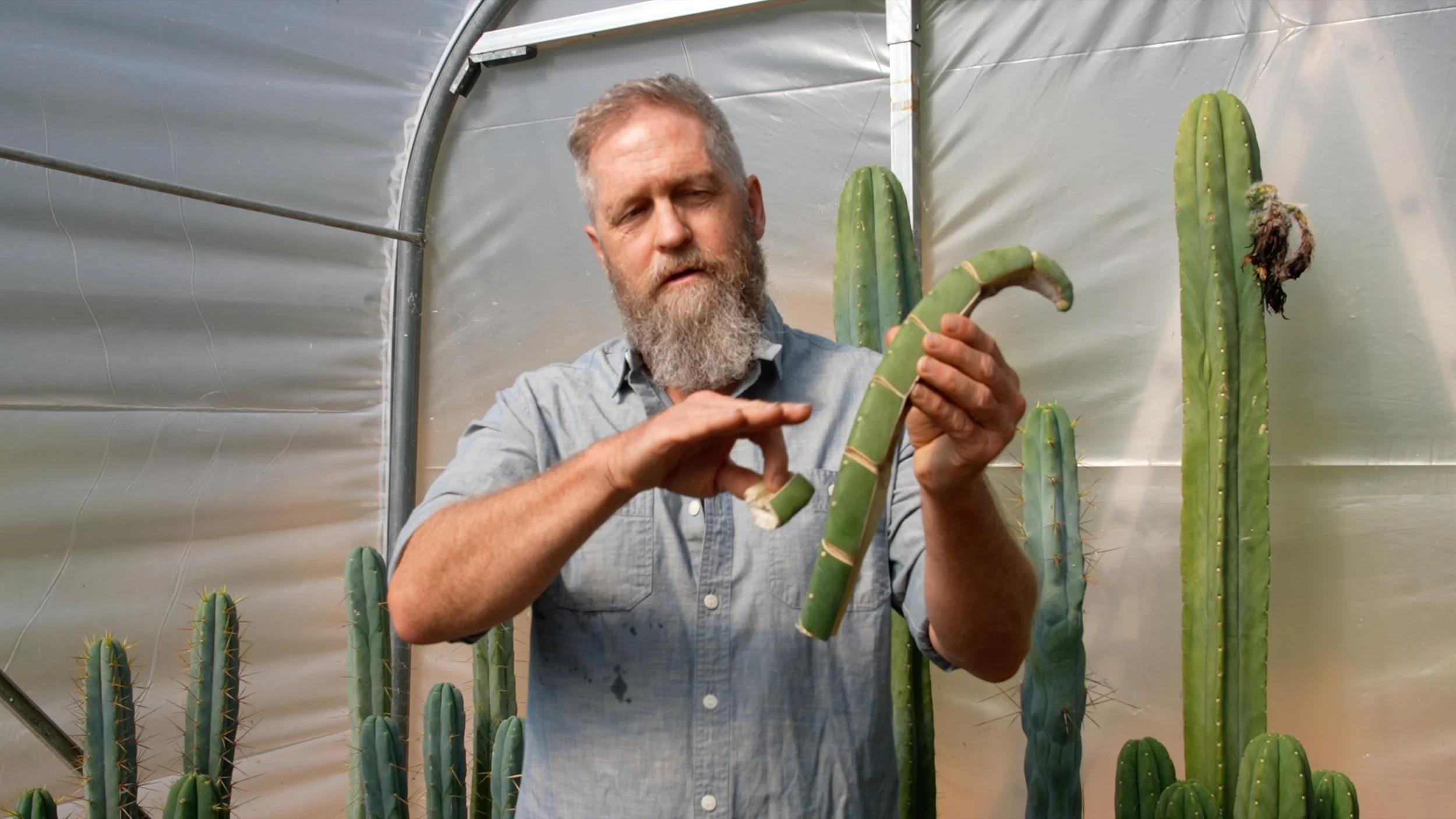
RIB DIVISION PROPAGATION TEK INFORMATION
A CENTRAL PLACE FOR INFORMATION ON PROPAGATION OF SAN PEDRO/TRICHOCEREUS CACTI FROM SMALL RIB SECTIONS.
This page is for information on the technique of propagating Trichocereus cactus by dividing ribs into small sections to be rooted indivisually. As of writing this, the process is still somewhat experimental. That it works in principle has already been demonstrated though and the main questions remaining have to do with timing and timeline. While some of the answers to those questions will inform us about the practicality of the approach in different contexts, I don’t have any doubt that it is useful in some contexts. So, I’ve decided to write down a basic how to, with caveats and qualifications, so that there is a central access point that is easy to find and share. I will update this page as I gain more experience.
5 inch pup growing off of a short section of rib. This grew from just budding to this size in 4 months. I’m hoping to grow them larger than this once the technique and timing are dialed in.
WHY DO THIS?
First, why would we want to do this? The technique is being developed to turn a relatively small amount of cactus into a lot of new plants. This effort is in response to certain contexts and problems. The most common method of propagation is rooting fairly large cuttings. One can stick small cuttings, but typically large pieces are planted. One problem with that common approach can be if there is simply not enough material to make a lot of large cuttings of a certain selection or cultivar. Another problem is that large cuttings take a lot of space. Also, if the cuttings are planted vertically, they can only be made so small and still have a significant amount of green showing for photosynthesis. Creating these small chips allows us to make a lot of propagation material from one column and photosynthesis efficiency can be optimized by planting at an angle so that the whole green part can fully face the sun.
(PHOTO PENDING- 2 INCH RIBLETS VS 2 INCH CUTTING
One major application is for large scale nursery work where sizeable numbers of plants are needed. Another scenario where the technique could be very useful is when taking a new cactus selection or cultivar from a small number of plants to a large number of plants. By the more typical approach, a new variety takes a few years to be propagated into significant numbers and will often command very high prices for a while. As an example, I grow thousands of cactus seedlings and am continually on the lookout for cactus which are special in some way and might be worth naming and getting out into the world. A new seedling takes some time to reach a large enough size to be evaluated and ready to cut and propagate. If one wants to speed that process up, an approach would be needed that can turn a small amount of cactus into a large number of plants reasonably fast.
Probably the most common approach to more rapid propagation is grafting. Grafting can drive growth fast, but it has its own limitations. Stock is required, and stock which is large and established enough to drive a lot of growth in a season takes a lot of space. Even the 5x5x8 inch pots that I frequently use for smaller grafting stock, take up a lot of space when numbers become significant. For better or worse, grafting can also, at least temporarily, affect the morphology of the cactus. Grafting and rib division can be complementary. Grafting can be used to increase propagation material quickly and then these small sections can be used to propagate the grafted growth into a large number of cactus in a much smaller amount of space and with less labor than grafting. The plants resulting from rib division will be smaller in the same amount of time, but if the goal is numbers over size, the shoe fits.
As an example, lets take 20 small pieces of cactus of a similar size, graft half of them and root half. The area taken up by the grafted ones in the smallest reasonable size pot to hold grafting stock would be 10 inches by 25 inches (250 square inches) in 5x5x8 square pots. In the small pots I’m using right now the 10 rooted chips would take up very little space. Lets say that I used 2.5 x 2.5 inch pot, which is about what I’m using- so a block 3 x 7.5 inches= 22 square inches. That small pot size may end up being too small, but the math will be favorable for any significantly smaller pot size. The grafted pieces will almost surely be larger (if they all survive) but then again they still have to be rooted. While the degrafted pup is rooting, the chip is expanding its already established root system and growing actively. Exactly when and where to use these techniques is up to anyone to assess in their own context. They are just tools with different uses.
More on reasons and places to use this tek at the bottom of the page.
Rib division or Riblet Tek. This is being developed to solve what I see as real world problems in cactus propagation. This one section of cactus produced 54 new pieces. The hope is that most will be decent sized new plants with good roots in about 12 to 14 months.
THE BASIC STEPS
Dividing the cactus into individual ribs on the standing plant
Healing the cuts for two or three weeks on the plant
Harvesting the ribs and dividing into riblets
Curing the riblets for two to four weeks
Planting the pieces in well drained soil and watering
DIVIDING THE RIBS ON THE PLANT
Originally I tried cutting fresh small sections of cactus to root. I had been starting to root some failed graft slabs and it seemed to be working. So a friend and I diced up a bunch of cactus into small bits to try rooting them. Most of them just dried up and died, even when curing in the shade. I noticed that pieces I grafted that ended up failing and coming off the grafting stock, were often still plump and would sit around for months seemingly unchanged. I realized the difference was that the grafts, although they failed in the end, were still receiving enough water from the grafting stock to remain hydrated as the cut surfaces of the graft slab were healing. I was also trying out an experiment of splitting the cactus into ribs, hoping that each rib would throw a pup, which could then be harvested, leaving the rest of the rib to sprout another. That did not work very well, but the two things came together and I realized the solution would be to divide the column into individual ribs on the plant, letting the long cuts heal while the plant is supplying them with water. I get my small pieces to plant, but they have a much smaller area to heal and lose water from when the cuts are made in two stages rather than all at once.
Grafting is super useful, but like any other propagation method it has its strengths and limitations. In this case I discretely cut just a few small pieces of this crested mutant I call “The Pet” from less visible areas of the parent plant and grafted them. That way I can leave the parent plant intact and grow these for a year to quickly get more propagation material. Grafting and Rib Division are complimentary if we understand them enough to know where and when to use each to best advantage. In the case of the the pet, rib division isn’t an option, though something like it may be, such as making many cuts with the cactus still on the roots, allowing them to heal before dividing them into their final sections and rooting. Essentially the same, just not with ribs.
There are three observed problems that we might see after cutting:
-Mold and rot could take hold. Air circulation and quick drying is important. Some kind of treatment could also help.
-The cactus will lose a lot of moisture after cutting and long individual ribs may flop over and even break, so they need support.
-The cuts can basically graft right back together if they are touching, so spreading them out while they heal is safer than leaving them as is.
Short columns are often self supporting and can simply be left alone. In drying they will often open up allowing air to circulate. They may heal back together if the cuts are touching though, so propping the ribs open is the safer way to go. Propping open also insures good air circulation and easier application of any disinfectant or coating for the cuts. For long cuts, some propping open and support is usually necessary.
My current plan for propping is a spiral of wire in a cone shape. My previous device, a spiral of wire tapering to both ends did the job, but not very well. I’m quite sure a cone shaped spiral of the right size will be at least adequate and probably pretty ideal. Another option might be a cone of wire mesh, such as 1/2” galvanized welded wire, though I have a feeling the wire coil will be better. You may be tempted to use various other materials or items, just remember the goal is not just the shape and supporting the ribs, but also air circulation. We basically want the least amount of contact with the cut flesh of the plant that will still do the job. A spiral of wire is easy to make and checks all the boxes well. It may be worth testing something like a wooden form, but I doubt it will work well.
(PHOTO PENDING, NEW COIL)
I would think it is most prudent to sanitize the wire spreader. One could coat the wire with something like sulfur or lime to inhibit any infection, but it is probably not necessary. Long ribs may need to be secured to the wire in one or two spots lest they flop over or even break as the ribs lose moisture and become flaccid. This tie could be something like a wire twist tie or string. Regardless, a couple of ties or rubber bands around the whole arrangment will keep things in place for the most part. Perhaps a spiral wrap of elastic material would hold them in position. Short cuts probably up to 8 or 9 inches, maybe 10”, shouldn’t need tying off or staking. For long sections a stake is also recommended.
(PHOTO PENDING RUBBER BANDED AND OTHER OPTIONS)
The ribs will become floppy and much more pliable as they dry out from the large amount of cut surface. If the ribs are too stiff and brittle to accommodate an internal cage for support and spreading, just wait a while. They should be much more pliable soon.
As far as treatments go, in very warm dry weather nothing is likely to be needed. I’d say the minimalist line of treatment would be to spray the fresh cuts with hydrogen peroxide. If more inhibition to infection is desired I’d look toward lime, aka calcium hydroxide. The photo below shows the results of cinnamon, sulphur and lime with a little sulphur applied to cuts before curing. My tests with lime (including in this same group of cuttings, I just didn’t have one when I took this picture) showed equal results to the lime sulphur. Lime is much more pleasant to work with than sulphur and completely non toxic. A dry dusting with a hand squeezed powder pump of the type used for applying micronized sulphur and diatomaceous earth, could be used to coat the fresh cuts. I have not used anything, but I would in certain weather conditions or times of the year and will be experimenting with treating the cuts in the future.
Some failed graft pucks. Rooting on these has often been slow, but once I started planting them more upright like this instead of flat, they seemed to root much faster. Failure rate has been surprisingly low, even for some pretty withered and sad small pieces. The riblets I’m making now are considerably larger and healthier for the most part, thus you would think they would perform better.
Shorter cuts may not need any support or propping open. The cuts can heal back together though if touching, so some spreading is probably more prudent. The horizontal cuts on these ribs have been abandoned for the time being.
On longer cuts, some kind of support is needed. This was an early experiment using a wire coil. The next experiments will use a similar coil, but cone shaped, much wider at the top, opening the ribs like a vase.
PLANTING/ROOTING
I suspect we can get away with sticking the riblets in soil after 2 weeks curing time. I stuck a batch at two weeks this year to find out. My usual curing time before sticking cuttings is about 4 weeks, so 4 is definitely enough.
I have been sticking the cuttings in the potting mix that I usually grow cactus in which is well drained. The more cactus I root, the less sophisticated. I just stick them and start watering.
I originally thought I would put the cuttings into flats planted very close together with something like a 1/4 inch between them for air circulation. I am trying that this season. For my situation and goals though, I am more interested in using the Anderson tree band system, which consists of a mesh bottomed tray that different dimensions of basically bottomless pots fit into tightly. Since the pots are square it is extremely space efficient. The trays are 15” x 15” inside, fitting 36 2-3/8” bands or 25 of the 3” bands. I am testing the 2-3/8 inch pots first in the hope that they will be large enough. I do think for growth and to prevent crowding, the 3 inch pots are better. The three inch pots come in three lengths, one being very tall. The 2-3/8” pots come in two sizes. I am using the taller one- 5-1/2”
Riblets stuck in a tray. these trays are about 11 x 19 inches and fit over two times as many chips per area as the 15 x 15 anderson trays with 2-3/8” pots. In some situations, this might be very useful. I would think that grow them out in the trays until they have sizeable pups before transplanting would be best, tin order o give the roots time to toughen up enough to survive transplanting and handling.
My original rib splitting experiments were about trying to trick the plant into thinking that each rib was a separate plant which would need to grow a new pup. It worked great on this one plant but hardly at all on most. But it was this experiment that was largely responsible for the rest coming together. Sometimes it pays to just experiment. One idea or results may lead to the next thing.
When cutting 6 or 8 ribbed cactus, the cut can often be made from one side to the other. When cutting those with an odd number of ribs, the cuts have to be made to meet at the center.
This cactus was left unsupported. The only reason it did not fall over completely and break was that it fell against a neighboring colum.
PHOTOS PENDING DUSTING PUMP AND LIME, AND APPLICATION)
I’m working on figuring out the best time late in the season to cut and still get the riblets rooting early enough to hopefully grow roots in the fall. Right now I’m working around mid august as a baseline, with 2 to 3 weeks curing on the plant. This timing will likely vary by climate and context. I’ll modify this article as I get more experience and results.
You will notice in some of the pictures that the ribs have horizonatl cuts as well. That was an attempt to make most of the cuts while the rib was still on the plant, with the idea that there would be less cut surface exposed on the riblets for the final curing of the riblets before planting. Mostly these horizontal cuts just healed back together. I noted that the rib sections seemed to cure just fine without this extra step, so it has been abandoned for now. At this point I just don’t think it is going to be necessary, or even helpful really.
HARVESTING DIVIDING AND CURING
Examining cactus this year (2025) they looked ready to harvest at 2 weeks. I harvested some at 3 weeks and they have been cured very nicely without excessive dehydration. They were cured in the shade during some very hot weather. I think two weeks will be enough. Three weeks was definitely enough. Water the cactus well while they are healing on the plant so that the ribs remain hydrated as much as possible. Ideally they will have a maximum amount of water when cut, feeling very plump. If they are not plump, water consistently and try to get them to where they look fat and feel very stiff and solid before you cut.
I divide the ribs into riblets 1-3/4” to 2-1/2” inches long. Much shorter than that is pushing the limit it I think. Very small pieces seem more likely to fail due to both infection and dehydration. They also leave less surface to photosnythesize. I’d say right now that an ideal size might be 2 to 2-1/4” but I may change my mind depending on the growth results this next season. I am sticking them in very small pots right now, so I don’t want the pieces too large. Also, the point is to maximize the amount of propagation material, and longer riblets means fewer riblets. The truth though is that length is largely dictated by the areole spacing anyhow. Usually each cut has two areoles, sometimes three if the areole spacing is close. I tend to make the top cut just above an areole, but will adjust the cut to wherever it makes a desired length. Pups sprouting from the curled over tips can be awkward and have to wright themselves in order to grow upward, so I think it is best to just cut off about 1/2 inch of the curled over tips.
If the weather is nice, I am likely to just leave the cuttings out in a shady spot with good air circulation. If I’m not sure of the weather, I’ll coat them with lime wash, SEE THIS ARTICLE. Dry powdered hydrated lime (calcium hydroxide- aka pickling lime, builder’s lime, mason’s lime or type s lime) may also work if the wet, fresh surfaces are treated. Air circulation is key. If the weather is dry a breezy shed or window is fine. If the weather is damp, I would coat with lime and put a fan on them for a day or so. Make sure they are laid out with adequate space between the cut ends for good air movement.
Left to right, cinnamon, sulfur and lime/sulfur. Lime performed just as well as lime/sulfur in these tests and that is what I use now. See this page for more on using lime. My next experiment will be dusting the new cuts with dry lime hydrate (pickling lime should work) using a bulb or powder pump of the type used for dusting with diatomaceous earth.
Rooting in trays will require extra labor during repotting, but more than twice as many can be rooted in the same space. That space efficiency will be especially beneficial on a large scale if bottom heat for rooting or lights for forcing growth and pupping are to be employed. If the cuttings are to be grown to a significant size, rooting in a tray and then putting the rooted cuttings into large pots, would seem to make sense. I would probably even leave them in the trays until they have significant sized pups. Waiting until they have some growth momentum will also mean more resilient roots that can tolerate transplanting without breaking. There are details to be figured out around all of that when it comes to scaled up nursery work.
My plan is more along the lines of sticking straight into the smallest pot I can get away with to get a plant that is ready to be planted into the ground (in a suitable climate for cactus) at around 14 months from the initial splitting. They will not likely actually be planted until the following spring, but that is the goal. The hope is for 5 inch pups or taller, but I don’t know what is possible yet. Larger pots are likely to mean more growth, but they also decrease space efficiency.
I usually cure cuttings of trichocereus for about 4 weeks, stick them in my normal growing mix and start watering. That seems to work well and failures from rot are rare. I’m sticking the latest batch at 2 weeks suspecting that is enough and being willing to risk finding out otherwise. 4 weeks should be very safe, but I want them to root in the fall if possible. I do expect a certain rate of failure, but when dealing with the numbers I’ll lay out here, a failure rate of 10 to even 20% may be perfectly acceptable. I very much doubt I’ll see an average failure rate of even 10% when things are dialed in. That is based on my experience so far, and there are probably ways failures can be reduced further and still keep a reasonable time line. My tendency is to think that when to stick a cutting has nothing to do with roots and everything to do with how well calloused the cut surfaces are. The presence or absence of roots should not make a lot of difference to the cutting becoming infected or not. If they can be stuck at 2 weeks, that helps shift things in favor of getting them rooted by the time winter sets in.
The riblets should be planted at an angle. It need not be planted deep. Just about 1/4 inch deep on the green side is enough. The angle is to maximize light exposure. think of the green face of the cutting as a solar panel collecting sunlight to make energy for the plant’s growth. About 30 to 45 degrees from vertical should be fine.
I’m rooting the cuttings in a greenhouse that is covered in 40% shade cloth. It is warm but the light is not too harsh. I want the soil to stay damp all the time basically, but without remaining soggy.
During rooting and growing out, especially in cool weather, bottom heat and lights might be beneficial. I can only speculate on a working system for that. One thought I had was to set up a light and heat table that chips are moved under for a period of time to induce rooting or pupping or both. After the prescribed time, they would be moved to make way for a new batch. This approach might be be useful for large scale nursery work. It sounds labor intensive and space intensive, but when talking about 36 plants in a 15” x 15” tray or even more plants in less space if stuck into flats, it could make sense and might be the difference between a 5 inch plant the following fall or a ten inch plant. Let’s say that period of time under lights or on heat is just a week. You could move four batches through in a month. A 30” inch heat/light table 90” inches long would hold 12 of the Anderson flats totaling 432 cuttings. If the cuttings were rooted in trays, we are looking at over twice as many maybe even 1000 a week. Using the anderson flats at a time of one week per batch, over 1700 cuttings could be moved through in one month. Using flats, maybe up to 4000? we’ll see I don’t want to go count them and do that math, but it's a lot!
Another thing I’m trying this year is rooting stimulants and rooting in water. Rooting in water sometimes seems to stimulate fast root emergence. Rooting in water with a rooting stimulant, might speed that up. Or the cuttings could be soaked for a few days in water with a rooting stimulant, then planted. There are a number of natural materials claimed to stimulate rooting, such as honey, willow and cinnamon, but not a lot of supporting evidence despite how easy it would be to make the experiments to find out. Making large numbers of these chips creates a great opportunity to do comparative testing with significant sample sizes and controls. I’m currently experimenting with willow tea compared to water.
The Anderson band system with 36 2-3/8 inch pots. This photo shows the drastic difference it can make to plant the riblets at an angle so that they can be turned to face the sun. For my goals, I want a saleable plant at 14 months if possible and I don’t want to transplant. The idea is to grow in these pots with out transplanting.
Experiments rooting in water and willow tea. These pieces are from the same varieties. They were cured for 2 and 3 weeks. So far, no rot 6 days in, changing the water/tea every two days.
GROWING
From there out it is just a matter of food, water and sun. Many people under fertilize and under water trichocereus. You can of course over-do it and kill them with kindness, but they really like food and water just like most plants and are fairly resistant to rot compared to many desert cacti. There is no need to ever let them dry out completely if the goal is rapid growth. I’m really wanting to get these things big in one season if possible, so I could see feeding weekly with a dilute liquid fertilizer.
SOME THOUGHTS ON APPLICABILITY
All the species of san pedro in Peru are now considered endangered. There seems to be no real hope of curbing rampant poaching of wild populations given the demand for dried powder. Suppose some farmers down there decided to form a cooperative and grow enough to offset wild harvesting. There would be certain problems to solve, such as coming up with desirable clones that meet processing criteria and then propagating those into adequate numbers.
I think San Pedro should be growing all over the place. If mega nurseries can produce thousands of plants and ship them all over the place to big box stores, that sounds great to me. It is not the perfect world, but it is a world with more san pedro! It would be nice to see them producing something besides the common PC clone though. Say a nursery wanted to expand it’s parent plantings for propagation material with some new varieties. rooting one larger cutting at a time is only going to do that so fast. Grafting will do it pretty fast if the stock is available to graft to. Lets take stubbs as an example. There are about 7 or 8 grafts of Stubbs, the original parent plant and two rooting pups. That is the sum total of all examples of Stubbs in the whole world. Oh wait, except the 54 riblets I made with one 18 to 20 inch section of column. Yeah, there’s that…
Every year we see the introduction of a few highly desired clones. In the early going, these can sell for insane prices until numbers start to keep up with demand. That process is shortened by grafting, but it could be shortened even more by rib division. Not only could one year old plants be produced cheaply, but these riblets could be distributed for planting or grafting quite cheaply. Cactus prices for larger cuts, which are the most common way to buy a new variety are just pretty high in general. For someone just getting into the hobby, it can be a real money pit. Let’s just to do a little math here. Lets say that one might spend 55.00 on a nice cut of one variety. Now lets say that you could come to my website, or someone else’s, and order chips for 5.00 each, which frankly seems a little pricey for standard clones. You could potentially get 11 new varieties for those same dollars. If we had a 10% to 20% failure rate, then we’re still looking at probably 8 or 9 surviving. I know from floating this idea that people are interested and it is probably going to happen. I need some experience with rooting first though so I feel like I can make solid recommendations. It is really pretty straightforward though- put them in well drained soil, don’t over water and no direct sun.
This is happening and I would think it will be found to be very useful. As I said before, it has all been shown to work in principal. I have encountered some odd resistance to this method. It seems to stem from emotional stuff, or maybe from unexamined assumptions. I may tackle those objections at some point, for my own amusement if nothing else. I confess to perhaps enjoying engaging these people a little too much and want them to argue with me so I can figure out what makes them tick and what their assumptions are. Suffice to say though that plant cuttings are a common way to propagate plants and basically the only way to clone cactus. I’m just using smaller pieces. Nothing else is materially different. What’s to argue with?
In one of my videos, I cut 8 columns ranging from about 19 inches at the longest, down to 8 inches. These 219 riblets are the result. One of my favorite instagram comments on this project so far by goldfish garage was “And all across the Internet cactus prices plummeted 🙌”



